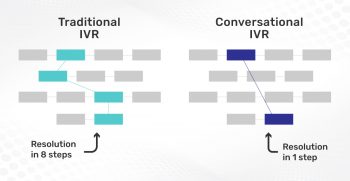Typically, every customer service interaction starts with a question or a request:
-
“What is the status of my order?”
-
“When is my credit card premium due?”
-
“I would like to modify my flight booking.”
A contact center agent has immense training and experience for efficient and accurate human language interpretation. However, agents are a skillful and expensive resource, and in current times, limited too as there has been a sudden shift to remote working due to covid-19. This is why contact centers are increasingly turning toward self-service as a valuable option.
Natural Language Understanding (NLU) is the foundation for self-service solutions that deliver 24/7 availability, flexibility, efficiency, and high customer satisfaction. This is the reason self-service solutions — like “chatbot” and “voicebot” — that can autonomously handle customer questions posed in natural human language — are becoming such a lucrative proposition for contact centers.

Above is a typical example of a conversation taking place between a human and a voicebot that’s been enhanced with Natural Language Understanding technology. Natural Language Understanding empowers customers to interact with systems and devices in their own words without being limited by a fixed set of responses.
Why Do Bots Need NLU?
Being able to interpret and understand what a customer is saying is critical of any good virtual voice agent or chatbot. Without the ability to understand accurately, any virtual agent is liable to frustrate your customers and increase the likelihood of customer churn.
Customer service interactions are complex. For example, many customers will use informal language, including local slang, colloquialisms, or business jargon, or will have deep accents and intonation while communicating with your customer service teams or virtual agents, making it extremely difficult to interpret what they are saying. Also, there are uncountable different paths a customer can take to express a single thought.
NLU is essentially the brain of a conversational, AI-powered virtual agent, where the following three components work together to decode the nuances of human language:
- Deep learning
- Natural language processing (NLP)
- Additional proprietary machine learning algorithms
Deep learning and natural language processing (NLP) are used for building the understanding capabilities of virtual agents. These technologies cover data training and right intent prediction models, and can also clean up customer requests to make them easier for any AI to understand.
Proprietary ML algorithms are pre-trained using industry-specific datasets to accurately identify the intent and entities for specific use cases.
The basic objective of NLU in a customer service chatbot or voicebot is to determine the connection between incoming text and speech from a user and the appropriate response. This response can be to provide a simple answer to a user question, or it could involve initiating an action that the user has requested, or it could be to store the information that the user has provided in response to a question prompt. Therefore, most bots break down NLU into three subtasks: classifying intent, extracting entities, and building context.
Intent refers to what the customer wants to accomplish through the interaction: it could be a simple question or a request. The bot needs to classify this request or question as either belonging to one of those intents it knows how to handle or to reject it as a “no-match” intent and transfer to a human agent. This will determine which of the actions or responses the bot will take.
-
“I would like to fly to New Jersey.”
-
> [Intent:] FLIGHT BOOKING
-
“What is the status of my order?”
-
> [Intent:] WISMO
Extracting entities is identifying and collecting information from the customer that is important to complete the request.
-
“What is your Departure City?”
-
> [Entity:]Boston
-
“Could you please confirm your order number?”
-
> [Entity:]1876598012
NLU comprehends the intent of the customer request, instead of simply the words being said. Moreover, it understands and builds the context of the discussion as well to create an interaction that flows naturally, instead of one that comprises sequential, standalone questions and answers.
4 Ways NLU Improves Customer Service
1. Accurate and Efficient Routing with Conversational IVR
On calling the contact center, it is usual to be greeted by the IVR, “Please listen to the following option”. After traversing the complex menu maze, there is a slight chance that your customers will reach the right agent/department who can help them with their requests. Let’s see how Conversational IVR, powered by NLU, can make this experience better and more accurate for the customer.
Joe calls because his order hasn’t arrived. He wants to track the status of the order. If it will take more time, he’d rather have a refund and buy it from the store instead. There are a few steps in that request, and the customer will probably need an agent.

Scenario 1: Joe goes through a traditional IVR
In a traditional IVR,
- Joe is greeted by the IVR. “Thanks for calling NextRetail. Please hear all the options carefully.”
- He will navigate through a set of IVR options.
- Once he reaches the right menu. He will input the order number and other details to track the status of the current order.
- And then he will press “9” to talk to an agent for refund issues.
- He will repeat his request and all the other information to the agent like the order number, the issue, and the current requirement.
Scenario 2: Joe goes through a conversational IVR
Conversational IVR simply asks your customers to state what they need help with. They can do this in their own words naturally before NLU steers them on their way.
- Joe is greeted by the bot. “Thanks for calling NextRetail. How can I help you today.”
- Joe just needs to say, “My order hasn’t arrived. I’d like a refund.”
- The NLU component will easily pick out “my order” and ‘refund’ as the important intents.
- The conversational IVR will capture important information from Joe like the order number.
Now, the conversational IVR hands over to an agent for refund related issue along with a tracking number for the order.
The agent has everything they need. They can dive straight into a resolution. That’s obviously a smoother experience for both the customer and the agent.
2. Autonomous Resolution to Customer Requests with Virtual Assistants
NLU-powered virtual assistants enable customers to easily engage with self-service systems by speaking or texting in their own words and using natural dialogue that mimics interaction with a live agent.
NLU captures the exact intent from the customer text or speech and helps the AI-powered bots to autonomously resolve customer queries.
3. Enhance Support Experience with Speedy Resolution
With your support teams receiving hundreds and thousands of support requests daily, you must ensure that agents are empowered to resolve them as accurately and speedily as possible.
Imagine you’re a customer support agent – you’ve multiple customers texting and calling you simultaneously. Your prerogative is to deliver resolution quickly and accurately while providing a satisfactory customer experience. Now layer on the need to update databases and CRM with customer information.
This model of customer support is not scalable and future-proof.
Customer support teams can leverage tools that use AI and NLU techniques — like chatbot and voicebot — to provide instant and accurate resolution to customer problems, akin to best human agents 24/7, with zero wait or lag time.
4. Increase operational efficiency
Tools that use AI and NLU techniques help enhance the capacity of the support system. In addition, they also help agents do more fulfilling tasks instead of monotonous, routine activities.
- Lower pressure on agents to rush through resolutions to shrink the queue
- Give agents more job satisfaction from handling challenging issues
- Quicker and successful issue resolutions due to intelligent routing and contextual information
Enterprises that implement chatbots and voicebots are better equipped to handle the sudden surge in support requests without increasing headcount and operational costs.
The way forward
As per Global Market Insights, “The market size for bots worldwide would be over $1.3 billion by 2024.” Hence, it is inevitable that AI-powered bots will become the driving force of communications between businesses and customers. Recent advances in deep learning and NLU techniques have opened up new possibilities and solve the complex challenges that businesses face while scaling their customer support operations.
So if you are ready to learn more about tools that use NLU techniques like Conversational IVR and voicebots, feel free to reach out to us.



